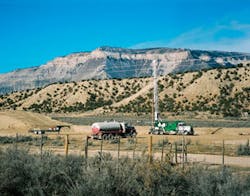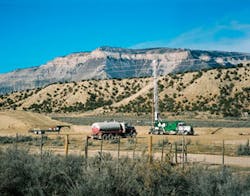Much of the opposition to drilling on part of the Roan Plateau in western Colorado comes from out-of-state environmental groups, said the Independent Petroleum Association of Mountain States (IPAMS) and the Colorado Oil & Gas Association (COGA).
The US Bureau of Land Management has authorized the drilling of up to 1,570 natural gas wells over 20 years on part of the Roan Plateau. The area involves federal land within the Piceance basin (OGJ, June 18, 2007, p. 31). The decision was issued by the Glenwood Springs, Colo., BLM field office.
US Rep. John Salazar, (D-Colo.), responded by saying he will try to get the House to amend the appropriations for the Department of the Interior. The measure would ban DOI spending on Roan Plateau leasing during the 2008 fiscal year.
Salazar said his decision stemmed from his constituents’ opposition to drilling on top of the plateau. Salazar is working with US Rep. Mark Udall, (D-Colo.), who also wants to stop leasing of the Roan Plateau, sometimes called the Naval Oil Shale Reserve.
On June 13, IPAMS said most of the comments received by BLM against drilling on the Roan Plateau came from outside Colorado, with Colorado residents contributing 7% of the total.
BLM received 74,906 comments on the Roan Plateau resource management plan, and 73,166 were form letters, with 65,543 of them sent via e-mail.
“I believe that Congressman Salazar is trying to do the right thing for Colorado, but it seems he is being misled,” said Marc W. Smith, IPAMS executive director. “There is no doubt that there are special interest groups who would like to stop all energy development in Colorado.”
COGA Executive Vice-Pres. J. Greg Schnacke agreed that “the national environmental movement” is targeting the Roan Plateau. He said East Coast environmentalists frequently target the western US, including Colorado.
“The state of Colorado is going to be the loser [if drilling is blocked]. It’s not like we’re talking about a national monument,” Schnacke said of the Roan Plateau. Wells already exist on private lands on the plateau outside BLM-administered lands atop Roan Plateau.
COGA estimates that the lease bonus payment alone could generate up to $1 billion the year the Roan is leased. In addition, the state could receive an estimated $166 million/year in royalties and production taxes.
BLM’s decision authorizes a highly restrictive approach to development on top of the plateau. Development is to be conducted in a staged approach. The plan calls for no ground disturbance of 52% of the area and access restrictions on an additional 42%.
The plan also outlines clustered development and directional drilling from common well pads to reduce land disturbance. It calls for a density of four well pads/sq mile.
There is to be phased drilling in only one of six designated areas at any given time. No drilling would be allowed in sensitive valley bottoms. Trout habitat and scenic waterfalls are off limits to drilling activity.
Schnacke said the plan involves a development plan that would take decades, and he questions how attractive it will prove to be for gas producers.
“It’s going to be a real challenge for some companies to be able to justify bidding on the projects,” Schnacke said, adding that many producers will not want the “hassle” involved with the federally-administered Roan Plateau.
“There is development there now, but it’s in areas not called the Roan Plateau. It’s going to take decades to get the gas out of the Roan Plateau. It’s ironic that an environmentally restrictive plan would force the industry to be up there longer than necessary,” Schnacke said.



